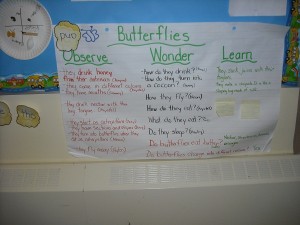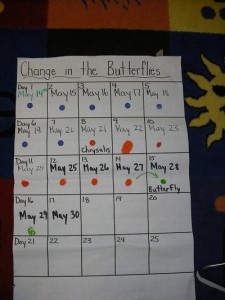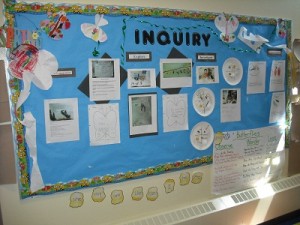 Our Inquiry on Growth and Change integrated the discovery of Butterflies.
Our Inquiry on Growth and Change integrated the discovery of Butterflies.
We created OWL (KLW) chart to see what the children already knew and had previously observed about butterflies.
We started asking questions about butterflies and observed the caterpillars in their jars and later they began forming their chrysalises. It was a great time to review questioning and how to formulate one. Once we discussed and read about butterflies the children began to develop deeper questions. For example; I wonder if butterflies can fly? to questions like… I wonder how they know when their enemies are coming? We also reviewed diagrams and how to label parts.
We created a chart to record how long it takes (passage of time) for the butterflies to change; from caterpillar to chrysalis, and chrysalis to butterfly. Some did not change all at the same time, and we compared our observations of change to what had been noted in videos and readings.
Students documented their observations in their journals.
We created an “I wonder” binder for the centre where children freely recorded their questions.
The children, along side the educators researched our questions through books, internet, and through short YouTube videos.
At the craft centre, children had the option to show their learning through recreating the life cycle with natural materials found outside to represent the different stages–real leaves, sticks, tree seeds for caterpillar bodies!
In the end, the children communicated to us their new learning through a written response and oral discussion. We released the butterflies at the 3 week period and we read an aboriginal legend about whispering a wish when you release the butterfly.
This is a great chart that shows how a read aloud (high support) is used to eventually become an Independent Resource (low support) for students to read on their own or at home.
One is done with a poem and the other is a Big Book that is repetative, and is simple to follow (level C). I just finished this book-I Went Walking with my class and they loved it. Here is a 5 day plan for the book. http://www.eworkshop.on.ca/edu/pdf/Mod08_WP_k_l_went_walking.pdf
Oral language is a critical part of the FDK program. Oral language is integrated into every aspect of the program to ensure children have a solid base for communicating their thoughts and ideas, develop comprehension skills, building social skills, and developing a good foundation for literacy.
Early on in September we begin expose children to letters and the associated sounds. Each board has different programs, but I follow the Jolly Phonics program. I collect assessment data late September/October to identify their oral language skills (OLA), letter and sound recognition, as well as DRA for SK. This will give me a good baseline to see where I need to plan, who needs further support in either small or large group.
Literacy blocks should include a combination of read aloud-supporting literacy strategies like retell, making connections, building comprehension, and gaining word knowledge; shared reading-emphasizing concepts of print like left to right, word by word reading http://www.eworkshop.on.ca/edu/core.cfm?p=modView.cfm&navID=modView&L=1&modID=8&c=2&CFID=11025755&CFTOKEN=e54e83faef4b802e-0E4CA749-1CC4-BC29-7C7D49BB15698087&jsessionid=f0307be8216bbe5ec1613b546519116024d1
independent reading where children have an opportunity to explore books of various genres either in the reading centres, during transition times, or in various centres.
A focus on letters and sounds is integrated into the literacy block so students can acquire these skills to develop a strong foundation for reading and writing.
The picture below shows a variety of books with some ideas on how they could fit into a reading block with a teaching focus.
There is a look at at variety of reading strategies that can be integrated into the literacy block. In the read alouds we are modelling for the students and building on their comprehension. Graphic organizers like a Go-Chart gives a visual of Charcters, Setting, Plot, Events, and ending.
Other ideas to include are the retell glove, working on schema, predicting, confirming, thinking about beginning, middle, end; asking what is your favourite part, sequencing, or comparing characters gets the children talking about books.
In essence, we want to move children along to become independent readers. This is a sample of ideas to include in a literacy block around reading. Responding to reading about their favourite part, connections, etc. also solidifies their learning and comprehension skills. Writing will be the next blog focusing on the literacy block.
On the site there is a great list of read alouds http://1000moments.net/wp-content/uploads/2010/10/List-of-books-in-200-format-FINAL.pdf suggested by teachers. There is a picture of the book and a comment about what it can be used for. There is a whole range of books that can help you begin your planning for the new year. Also, if you have a book you can submit the information to be added to the list! http://earlylearningcentral.ca/?page_id=424 . You can also access this information under the tab across the top called “Resources”.
Beside our dramatic play centre, I placed one of our smaller tables, near the windows with my signs for the flower shop. In the centre of the table, I put a basket of pencils and markers and some blank paper. When I introduced the centre to the children, I told them the flower shop needed help. I explained that we needed more signs and pictures of flowers for customers to see. I also told them we were running out of order forms for when customers called in to the store for deliveries, and asked if they could help make some of these to help.
It was amazing to see what the children created! We had beautiful pictures, sale signs, and unique order forms. One child even made a price list of flowers. She drew flowers on one half of the paper and numbers on the other!
It never amazes me what children can create, if given enough time and opportunity.
Our Kindergarten Literacy centre became a little messy today…..I brought in a few cans of shaving cream. I bought the unscented kind. As a literacy station, I set up 4 chairs at a table. I had plastic letters as models for the children to see. I had each child put on an art smock so their clothing did not get ruined. I gave each child a medium sized mound of shaving cream (egg-sized) on the table in front of them. Then, I told the children to use their hands to spread it around and then use their fingers to create the letters.
The children loved it! They wrote their names in it too! Next time, I can have them write their sight words in the shaving cream.
To help our children visually recognize the letters of the alphabet, we pretend we are marching around the alphabet to the song listed below. Depending on how many children are in your class, you can decide how many children can show the class their letter and tell them what it is. In our room, we have 28 students, so we sing it 4 times and allow 7 children to “teach” the others about the letter they chose each round. To hear the song, you can look it up on YouTube, or Google it. You can also buy the CD.
Marching Around The Alphabet
Words and Music: Hap Palmer
We’re marching around the alphabet, around the alphabet.
We’re passing letters from ABC, all the way to XYZ.
We’re marching around the alphabet, around the alphabet
Where we stop nobody knows, until the whistle blows.
(Whistle Sound)
Now bend down right where you are,
Pick a letter that’s near your toes.
When the teacher points to you,
Tell the teacher which letter you chose.
Tell the teacher which letter you chose.
Put your letter back on the ground
Stand up tall and march around.
We’re march around the alphabet, around the alphabet.
We’re passing letters from ABC, all the way to XYZ.
In our classroom, we have 4 large windows. I looked at them and thought they needed to be decorated! So, I went to Wal-Mart and got the washable window markers. As a literacy centre, we have been letting the children use the markers to practice drawing people, as well as to practice printing.
Some days we have the students print their names. Other days, we have the students create lists of our sight words from our word wall. There are also days were they can write a story and draw a picture.
We have this as a centre every other week so the children’s work can be displayed for a week before we begin with a clean slate again.




Recent Comments